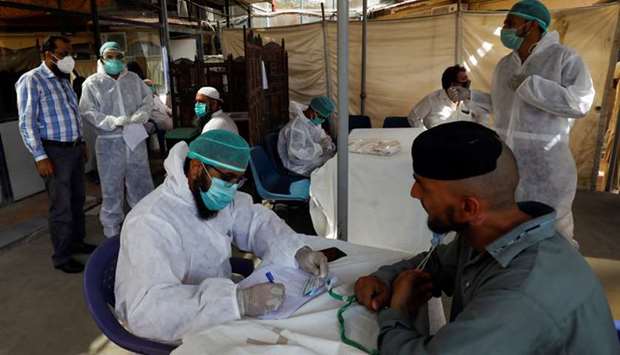Karachi’s District East has emerged as the most-affected coronavirus affected area in Sindh, where around 15,669 people have tested positive for the virus, the highest number of cases in any district of Pakistan.
The coronavirus causes the Covid-19 respiratory disease.
“Not just in terms of cases, but the District East of Karachi has recorded the highest number of deaths, which is 311, since the first death occurred due to Covid-19 on March 19, 2020, in Sindh,” said a provincial government official. “Nobody knows why the number of cases is so high in District East, which is equal to the combined number of Covid-19 cases of the Malir, Korangi and West districts of Karachi.”
A city of 16,051,521 people, as per the 2017 census, Karachi had recorded 55,459 cases of Covid-19, while around 1,000 people had lost their lives by June 26, the official said.
“Twenty-five per cent of the recorded Covid-19 cases and deaths in Pakistan have been reported in Karachi. It is has emerged as the most-affected city of Pakistan, where the number of cases on June 26, 2020, is 195,745 with 3,962 deaths.
“We are trying to find out as to why cases and deaths in this district are more than they are in three other districts West, Malir and Korangi, which have a three times bigger population than that of District East.”
The official, who requested anonymity as he was not authorised to speak to the media, said that according to the 2017 census, the population of District East is 2,907,467, and it comprises areas like Gulshan-e-Iqbal, Gulistan-e-Jauhar, Jamshaid Road, Mehmoodabad, Bahadurabad, Hasan Square, Sachal and Safoora Goth, and Abul Hasan Isphahani Road, where the residents are typically better off financially and more educated.
“But when we see the statistics, District East has emerged as one of the most-affected areas. During 24 hours between June 25-26, eight people lost their lives, which is the highest number of deaths in any district of the province,” the official added.
Karachi’s District Central is the second most-affected district in Sindh in terms of deaths, with 208 people having died due to Covid-19 since March 19, Sindh government officials said, adding that with almost the same population (2,971,626) as District East, District Central had 9,869 cases on the morning of June 26.
“Although District Central has around 5,000 fewer cases as compared to District East, it has the second-highest number of deaths in the province. This district also comprises areas where the most educated class of Karachi lives, while people in this district are also well off as compared to those in other areas of Karachi.”
Karachi’s District South, which comprises two richest and educated as well as poor and uneducated areas of Karachi, i.e. Defence and Clifton on one side and Lyari on the other, has emerged as the third most-affected area, officials said, adding that so far 13,372 people had been found infected with the coronavirus, and 181 people had lost their lives in various areas of the district.
With 128 deaths, the most populated district of Karachi, West, is the fourth most-affected district in Sindh, officials said, adding that despite having a population of around 3.9mn, District West had only 5,434 cases of Covid-19 by June 26.
“The smaller number of cases in the most populated district of Sindh could be due to the fewer number of tests conducted, but 128 deaths also indicate that it is not as badly-affected area as District East or District Central,” the official said.
With a population of more than 2.4mn as per the 2017 census, the Korangi district is the fifth most-affected area of Karachi, with 93 deaths by June 26, officials said, adding that 5,059 people had been found infected there.
The District Malir of Karachi, which comprises mostly rural areas and where most residents are considered less educated, is the least-affected district in the city, officials said, adding that only 72 people had died due to the coronavirus, with 6,056 people infected.
Commenting on the situation, eminent infectious diseases expert Dr Faisal Mehmood said that normally people of low socioeconomic status are more likely to contract infectious diseases compared to those who from the well-off segments of society, as they latter tend to take better care of their health due to their level of awareness, education, and better opportunities and resources.
“In the low socio-economic segment of society, people are less educated, and their level of awareness is also low. They live in congested localities, with more people in small houses, which is the case in our katchi abadis and poor areas.
“As they can’t enjoy the luxury of having their separate rooms, they are more likely to get affected as soon as the first member of their family is infected by Covid-19,” Dr Mehmood observed.
When asked why more cases were being reported from well-off areas of the city compared to the poorer localities, he said that this could be due to a higher number of tests in the former.

A paramedic at a facility in Karachi takes notes of a man’s health history before taking a nose-swab sample to be tested for the coronavirus disease.
